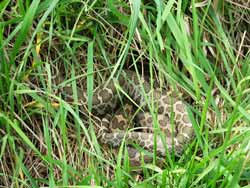Rare fungus kills endangered rattlesnakes in southern Illinois

Photo courtesy: Matthew Allender <br>The eastern massasauga rattlesnake normally spends spring in shallow wetlands and summer in drier upland areas. <br>
The eastern massasauga rattlesnake (Sistrurus catenatus catenatus), a candidate for protection under the federal Endangered Species Act, suffers from habitat loss and environmental stresses wherever it is found, said University of Illinois comparative biosciences visiting instructor and wildlife veterinarian Matthew Allender, who led the health investigation.
Long-term population studies of the snake – in Illinois and elsewhere – had never turned up evidence of debilitating fungal infections. But in 2008, biologists studying the snake reported to Allender that they had found three sick snakes in a park in southern Illinois, all with disfiguring lesions on their heads. The snakes died within three weeks of their discovery. A fourth snake with a similar syndrome was discovered in the same park in the spring of 2010.
Allender conducted necropsies on the snakes and identified the pathogen that had killed them: Chrysosporium, a fungus that plagues portions of the pet reptile industry but is not normally seen in the wild, he said.
“Chrysosporium causes disease in bearded dragons and in other snakes and it’s a bad bug,” Allender said. “We see it in captive animals worldwide, but we don’t typically find it in free-ranging animals.”
Chrysosporium also is emerging as a dangerous infection in humans with weakened immune systems, he said.
Shortly after he first presented his findings at a meeting of the Fish and Wildlife Service, Allender heard from other biologists about similar infections in snakes in the northeast United States.
“They seem to be having a similar problem in timber rattlesnakes in New Hampshire and Massachusetts,” Allender said. Although biologists have sporadically identified Chrysosporium in those snakes, the symptoms they report – facial swelling and ulcers and malformations of the jaw – are the same, he said. These infections also occurred only within the last five years.
“Fungal pathogens have been increasingly associated with free-ranging epidemics in wildlife, including the well-known effects of Batrachochytrium dendrobatidis on frog populations globally and white-nosed syndrome in bats,” Allender wrote in a December 2011 report in Emerging Infectious Diseases. “Both of these diseases cause widespread and ongoing deaths in these populations that seriously threaten biodiversity across the United States.”
Allender sees this new occurrence of a fungal infection in endangered snakes as a “yellow flag” that warrants more study.
“Wildlife diseases and human health are not that different,” he said. “And often wildlife are our window into a weakened environment that leads to disease in both people and animals.”
Editor's note: To contact Matthew Allender, call 217-265-0320; email mcallend@illinois.edu.
The paper, “Chrysosporium sp. Infection in Eastern Massasauga Rattlesnakes,” is available online.
Media Contact
More Information:
http://www.illinois.eduAll latest news from the category: Ecology, The Environment and Conservation
This complex theme deals primarily with interactions between organisms and the environmental factors that impact them, but to a greater extent between individual inanimate environmental factors.
innovations-report offers informative reports and articles on topics such as climate protection, landscape conservation, ecological systems, wildlife and nature parks and ecosystem efficiency and balance.
Newest articles

Superradiant atoms could push the boundaries of how precisely time can be measured
Superradiant atoms can help us measure time more precisely than ever. In a new study, researchers from the University of Copenhagen present a new method for measuring the time interval,…

Ion thermoelectric conversion devices for near room temperature
The electrode sheet of the thermoelectric device consists of ionic hydrogel, which is sandwiched between the electrodes to form, and the Prussian blue on the electrode undergoes a redox reaction…

Zap Energy achieves 37-million-degree temperatures in a compact device
New publication reports record electron temperatures for a small-scale, sheared-flow-stabilized Z-pinch fusion device. In the nine decades since humans first produced fusion reactions, only a few fusion technologies have demonstrated…





















